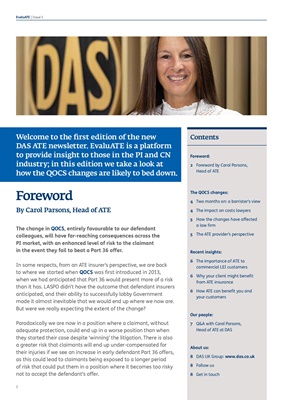
Foreword
By Carol Parsons, Head of ATE
The change in QOCs, entirely favourable to our defendant
colleagues, will have far-reaching consequences across the
PI market, with an enhanced level of risk to the claimant
in the event they fail to beat a Part 36 offer.
In some respects, from an ATE insurer's perspective, we are back
to where we started when QOCs was first introduced in 2013,
when we had anticipated that Part 36 would present more of a risk
than it has. LASPO didn't have the outcome that defendant insurers
anticipated, and their ability to successfully lobby Government
made it almost inevitable that we would end up where we now are.
But were we really expecting the extent of the change?
Paradoxically we are now in a position where a claimant, without
adequate protection, could end up in a worse position than when
they started their case despite 'winning' the litigation. There is also
a greater risk that claimants will end up under-compensated for
their injuries if we see an increase in early defendant Part 36 offers,
as this could lead to claimants being exposed to a longer period
of risk that could put them in a position where it becomes too risky
not to accept the defendant's offer.
Welcome to the first edition of the new
DAS ATE newsletter. EvaluATE is a platform
to provide insight to those in the PI and CN
industry; in this edition we take a look at
how the QOCs changes are likely to bed down.
Contents
Foreword:
2 Foreword by Carol Parsons,
Head of ATE
The QOCs changes:
4 Two months on: a barrister's view
4 The impact on costs lawyers
5 How the changes have affected
a law firm
5 The ATE provider's perspective
Recent insights:
6 The importance of ATE to
commercial LEI customers
6 Why your client might benefit
from ATE insurance
6 How ATE can benefit you and
your customers
Our people:
7 Q&A with Carol Parsons,
Head of ATE at DAS
About us:
8 DAS UK Group: www.das.co.uk
8 Follow us
8 Get in touch
2
EvaluATE | Issue 1